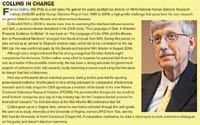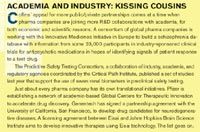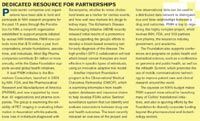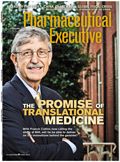The Building Block of Drug Discovery
Pharmaceutical Executive
With Francis Collins now calling the shots at NIH, will be be able to deliver on the innovations behind the genome?
Francis Collins devoted more than 15 years in the lab to deciphering the human genome, an intensive labor of love that yielded new tools for diagnosing and curing disease. Ten years later, as Director of the National Institutes of Health (NIH), Collins finds himself in another unique position: to deliver on the promise of the genome through the translation of research into technologies, products, and services that are clinically relevant and commercially marketable. To underscore his agenda for closer interaction with the private sector, and in anticipation of some rough sledding on the budget front this year, Collins recently sat down with Pharm Exec to explain why these and other initiatives are critical for NIH, the industry, and public health.

It is rare for any scientist to have the opportunity to drive a new discovery and then help seed its benefits in the real-world setting of patients, but this is precisely where Collins aims to distinguish his tenure as NIH chief. Certainly the tools are there for him to make an impact. The NIH is the world's largest institution of biomedical research, with a $31.2 billion budget distributed among 27 different medical institutes, largely in the form of research grants to 325,000 scientists working at more than 3,000 scientific enterprises.
Collins regards translational medicine as the key to turning knowledge about genetics and disease into new treatments that can benefit patients. This past December, an NIH advisory committee recommended establishing a new NIH National Center for Advancing Translational Sciences, a move engineered by the NIH director to bring together a number of programs that provide resources for translating basic discoveries into new medicines and diagnostics. The goal is to encourage more collaboration between academic researchers and biopharmaceutical companies and to strengthen ties to the Food and Drug Administration (FDA) to ensure that NIH-sponsored studies provide the information needed to support product registration. In the process, Collins' translational science campaign aims to convince Congress and the public that the federal investment in biomedical research will pay off in terms of new, life-saving therapies.

Collins in Charge
In fact, a critical task for Collins this year is to convince Congress to provide healthy funding for NIH amidst plans to cut federal outlays. Flat NIH budgets during the last decade created a huge pent-up demand for funds, which quickly absorbed the extra $10 billion provided by the 2009 stimulus package. Even though the White House sought a 3 percent increase for NIH for 2011, Congress never approved it, and most federal agencies are currently operating at last year's funding levels. Analysts at Deutsche Bank predict that NIH budgets will remain flat, while investment in science and basic research is on the rise in Europe, and even more in China.
Collins pressed for Committee approval of the new translational sciences center in December 2010 to be able to include it in the administration's 2012 budget plan and thus obtain initial funding this fall. But the lack of new money for NIH means that most of the $700 million that would be needed to support translational sciences will have to come from existing funds. That makes the research community nervous, as well as pharma companies that want NIH to continue its focus on basic research. Richard Klausner, former director of the National Cancer Institute and now a biotech venture capitalist, is skeptical of a larger shift of NIH resources to translational medicine. "NIH research should provide a better understanding of human pathology and its relation to disease and treatment, he says, and "then translation will occur."

Many observers note that translational medicine and public/private partnerships are not new to NIH. The agency's previous director, Elias Zerhouni, launched the NIH Roadmap Initiative to speed biomedical discoveries from the bench to the bedside. The Foundation for NIH (FNIH) has bred numerous industry collaborations with individual NIH Institutes for more than 10 years (see sidebar).

Academia and Industry: Kissing Cousins
Yet, little translation of biomedical research will happen if the private sector does not detect a positive climate for new drug research based on basic economic calculations around risk versus benefit in committing large sums of money over long periods of time. Collins says the role for NIH is to "de-risk" the process of drug development and to leverage its own human and financial capital to foster better partnerships with Big Pharma and biotech.
New Landscape
Collins sees a rapidly changing biomedical research landscape as the prime driver behind stronger NIH partnerships with the pharmaceutical industry. He's optimistic that new genetic discoveries can chart pathways for discovering new medical treatments, and that the emergence of more well-validated genes will be useful in "identifying drug targets in unprecedented numbers."

Dedicated Resource for Partnerships
At the same time, biotech and pharma companies face serious financial challenges in funding research projects. "These are not easy times for the development of new therapeutics," Collins allows, noting that venture capital is limited and many biotech companies are struggling to stay afloat.
"So it's kind of the best of times, and worst of times," he observes. The scientific enterprise is yielding up a lot of new ideas about therapeutics. Yet, "the traditional private sector efforts to capitalize on that are taking a hammering." NIH, thus, is "an attractive alternative" for supporting new partnerships between academic researchers and industry.
This was not the case six or seven years ago, Collins said. Back then, pharma companies did not consider academic research institutes a prime source of support for drug development. Conversations with industry about collaboration were not that productive, especially suggestions that companies open up compound libraries to outside parties. The general response, Collins recalls, was "No, we're not going to share our crown jewels with you; we might find something to do with those later."
Now, says Collins, "it's all changed." He detects more private sector interest in NIH-funded preclinical and clinical testing, as well as in compound rescuing or "repurposing." Pharma companies have long lists of compounds that have been abandoned along the way, maybe because a business plan changed or the money ran out or clinical trials failed to show efficacy, Collins notes. "We have been talking with leaders in the pharmaceutical industry about an opportunity to open the freezers and make such compounds available, with appropriate intellectual property protection for them," Collins explains. "This isn't a giveaway, but could be a win-win if such a compound were found to be active for a different application than originally considered."
Yet, scientists at pharma companies maintain that it takes considerable work to identify failed or abandoned compounds suitable for further research. Providing materials to NIH for drug repurposing is not straightforward, explains Amgen R&D chief Roger Perlmutter. "Every step along the way requires real effort on the part of very busy people doing other things."
Collins has an eye out for tax provisions, patent incentives, and regulatory assistance that can encourage such collaboration. And he emphasizes that NIH won't move into full drug development, but will support projects just long enough for them to become attractive for a biotech or pharma company to pick up. For a completely new molecular entity to treat a common disease, "I suspect the interest in the private sector would be very high, very early," he says. Conversely, a treatment for a rare disease that affects only a few hundred patients is not likely to generate much interest until further along. NIH is prepared to contribute to promising projects as far down the line as it has to—"but no further," he maintains.
Bench to Biotech
The NIH translational sciences center envisioned by Collins would house a spectrum of programs now scattered among different NIH entities, according to the report to NIH's Scientific Management Review Board, which was established two years ago to examine and recommend changes in the agency's vast organization and structure. Current translational research programs cover the development waterfront, many funded by the director's Common Fund, a $500 million kitty that Collins administers to support cutting-edge, trans-NIH projects. Instead of shifting these activities to an existing NIH institute, the advisory group thought it best to establish a new organization to emphasize the importance of these changes. Under the proposal the new Center will contain NIH's:
Molecular Library and Chemical Genomics Center. A network of high-throughput screening centers that can assess thousands of possible drug targets against library compounds and provide researchers with chemical probes to study the functions of genes, cells, and biochemical pathways.
Rapid Access to Interventional Development (RAID) program. Makes available developmental resources and services that support product formulation, test compound production, pharmacokinetic (PK) assays, animal toxicology testing, and assistance in navigating the regulatory process. NIH has fully renovated its in-house drug production operation so that it can produce custom-made pills, vaccines, and injectibles—along with placebos—for preclinical testing and clinical trials using state-of-the-art equipment that meets FDA good manufacturing practices standards.
Therapeutics for Rare and Neglected Diseases (TRND) program. Supports preclinical animal and PK testing to bring potential treatments for neglected diseases through the "valley of death." One TRND pilot seeks new treatments for schistosomiasis, a disease affecting some 250 million people in Africa, but neglected by industry and researchers for decades. Another project supports preclinical testing of an orphan drug for sickle cell disease discovered by a small biotech company, AesRx of Massachusetts. TRND also is tackling very rare conditions, such as hereditary inclusion body myopathy and Neimann-Pick Type C, a disorder of lipid metabolism. The goal is to get to the point where a private sponsor could apply for an IND (investigational new drug application) with FDA to launch clinical studies.
Clinical and Translational Science Awards (CTSAs) program. The most controversial recommendation is to shift this network based at 55 academic health centers, which receives about $500 million a year from NIH, to provide translational support to clinical research efforts. The move, though, would rob the National Center for Research Resources (NCRR) of nearly half its budget, prompting heated opposition from NCRR staff and grantees.
One interesting component that would move with the CTSAs is the Pharmaceutical Assets Portal, designed to match up research scientists with abandoned or off-patent drugs available for rescue or research. The Portal wants to include compounds from pharma companies, but so far only Pfizer has become involved. The Portal organizers hope that a new discontinued clinical compound library of fully tested products will attract broader support.
Cures Acceleration Network (CAN), which was authorized by last year's health reform legislation to fund drug development projects. The new Center would provide a visible home for CAN if it is ever fully funded by Congress. An initial $50 million budget for 2011 is still on hold, and the outlook is dim that it will ever become the $500 million program originally sought by former Senator Arlen Specter.
Several NIH activities may remain outside the new Center, such as the Pharmacogenomics Research Network (PGRN), a group studying how genes affect patient response to medicines for cancer, heart disease, asthma, nicotine addiction, and other conditions. The panel also decided to leave NIH's Clinical Center as a distinct entity, but with strong links to the Center.
FDA Partnership
The new Center also will support NIH collaboration with FDA. Collins acknowledges the importance of ensuring that federally funded research produces information needed to gain FDA approval of a test therapy and has formed a "real partnership" with FDA commissioner Margaret Hamburg to achieve this objective. A year ago this month, the two agencies announced a formal collaboration, with an NIH/FDA Joint Leadership Council providing a forum for communication between FDA and NIH research sponsors and a process for agency staffers to discuss clinical protocol questions.
Under the collaboration, NIH is funding several research projects designed to assist product development and enhance regulatory review. The first round of grants, which total $10 million over three years, support research on predicting harmful effects of nanoparticles in drug delivery, new models for safety and efficacy screening of drug candidates, innovative statistical methods and study designs for clinical trials, and a novel strategy for predicting eye irritation in clinical studies.
Collins acknowledges that the funding is very modest, but more than what FDA has for this kind of research. FDA chief scientist Jesse Goodman regards FDA's collaboration with NIH as a real "culture change, and recognition that FDA's engagement in the development of medical products is very important." Ellen Sigal, chair of Friends of Cancer Research, agrees that a mechanism for the two agencies to query each other on endpoints and adaptive trial designs should be very useful. "Anything that anyone can do to help FDA make decisions based on science is incredibly important," adds Richard Klausner.
Conflicts and Collaboration
One assignment for the new Center is to reduce barriers to public/private collaboration that can be created by conflict-of-interest (COI) concerns and intellectual property (IP) issues. Collins is working to put "NIH's COI house in order" with more stringent and more transparent financial reporting requirements. Pharma and academic researchers fear that the strict standards will discourage joint projects, just as broad "Sunshine" policies governing pharma payments to doctors threaten to undermine industry relations with health professionals. Yet Collins maintains that collaborative relationships can't even appear to provide personal financial benefit to academic partners funded by NIH, or that could raise doubts about the validity of resulting research.
Equally challenging is the task of balancing open access to research data against IP protection. NIH wants to establish models for collaboration agreements and licensing arrangements, although Collins sees most discoveries from public/private collaborations residing in precompetitive space; exclusive licensing agreements should be "limited to circumstances where it's really needed as an incentive for product development," he says. Collins made waves in September 2010 by announcing that NIH would license a key protease inhibitor to the UNITAID HIV medicines patent pool, a move designed to spur pharma companies to take similar action.
R&D Support = Lower Prices?
Drug pricing is another issue that emerges in discussions about NIH/pharma collaborations. Collins doesn't see NIH trying to influence drug prices per se, blanching at remembrance of the "reasonable pricing" debate that made industry very skittish about partnering with NIH back in the '90s. Yet, he also is concerned about the trend toward more high-cost therapies. "The market can't bear $93,000 for compounds across the board that give you four months of additional quality of life," the NIH director told Science magazine in May. "That's just not going to be sustainable."
Instead of pressing for lower prices, Collins looks to reduce upstream R&D costs—and resulting product prices—by providing data that supports smaller clinical trials and by rescuing abandoned compounds. "If we could simply improve success rates by a factor of two—you know, only a 90 percent failure rate—that would be a phenomenal achievement," he enthuses. Throwing out unpromising projects is key to improving the process, he adds: "People should be rewarded for having the courage to do that."
Looming Budget Squeeze
The dark cloud over these and other NIH initiatives is an ever tighter funding climate for federal agencies. "That's what keeps me awake at night," Collins says. "We have such exciting scientific opportunities now, but we're really in a squeeze as far as our ability to support them."
While trying to figure out what NIH can afford to do, Collins insists the wrong move is to "just hunker down and not try anything new." He notes that translational science will be just a tiny part of NIH's $32 billion budget, at most 1 percent of its funds. And translation, he adds, "gets a lot of traction with Congress as well as the public."
Collins values industry input and expertise in implementing his vision for a more effective and collaborative approach, recently luring Rajesh Ranganathan from the Novartis Institutes for Biomedical Research to be a senior advisor. And he's meeting with pharmaceutical executives to discuss practical issues related to drug repurposing efforts, and to see "who wants to play," explains Christopher Austin, who came to NIH in 2003 from Merck to help Collins tackle many of these same issues arising from the human genome project; Austin heads TRND and the chemical genomics center, both on the list of activities for the new translational sciences center.
Collins cheered the advisory panel's recommendation to establish his new entity as a "momentous occasion" because it was based on "scientific arguments" and not politics. Drug development is at "a critical juncture," he told the committee. Filling the biomedical pipeline requires a whole new approach, he said, and "not an incremental tweaking of the system." Pushing for such a significant organizational change at NIH in a very short time is certainly risky. But NIH "is about innovation," he emphasizes. "It's about taking risks."

Addressing Disparities in Psoriasis Trials: Takeda's Strategies for Inclusivity in Clinical Research
April 14th 2025LaShell Robinson, Head of Global Feasibility and Trial Equity at Takeda, speaks about the company's strategies to engage patients in underrepresented populations in its phase III psoriasis trials.
Beyond the Prescription: Pharma's Role in Digital Health Conversations
April 1st 2025Join us for an insightful conversation with Jennifer Harakal, Head of Regulatory Affairs at Canopy Life Sciences, as we unpack the evolving intersection of social media and healthcare decisions. Discover how pharmaceutical companies can navigate regulatory challenges while meaningfully engaging with consumers in digital spaces. Jennifer shares expert strategies for responsible marketing, working with influencers, and creating educational content that bridges the gap between patients and healthcare providers. A must-listen for pharma marketers looking to build trust and compliance in today's social media landscape.